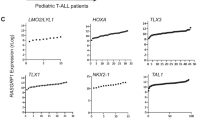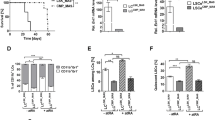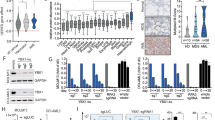Abstract
Activation of NRas signaling is frequently found in human myeloid leukemia and can be induced by activating mutations as well as by mutations in receptors or signaling molecules upstream of NRas. To study NRas-induced leukemogenesis, we retrovirally overexpressed wild-type NRas in a murine bone marrow transplantation (BMT) model in C57BL/6J mice. Overexpression of wild-type NRas caused myelomonocytic leukemias ∼3 months after BMT in the majority of mice. A subset of mice (30%) developed malignant histiocytosis similar to mice that received mutationally activated NRas(G12D)-expressing bone marrow. Aberrant Ras signaling was demonstrated in cells expressing mutationally active or wild-type NRas, as increased activation of Erk and Akt was observed in both models. However, more NRas(G12D) were found to be in the activated, GTP-bound state in comparison with wild-type NRas. Consistent with observations reported for primary human myelomonocytic leukemia cells, Stat5 activation was also detected in murine leukemic cells. Furthermore, clonal evolution was detected in NRas wild-type-induced leukemias, including expansion of clones containing activating vector insertions in known oncogenes, such as Evi1 and Prdm16. In vitro cooperation of NRas and Evi1 improved long-term expansion of primary murine bone marrow cells. Evi1-positive cells upregulated Bcl-2 and may, therefore, provide anti-apoptotic signals that collaborate with the NRas-induced proliferative effects. As activation of Evi1 has been shown to coincide with NRAS mutations in human acute myeloid leukemia, our murine model recapitulates crucial events in human leukemogenesis.
This is a preview of subscription content, access via your institution
Access options
Subscribe to this journal
Receive 50 print issues and online access
$259.00 per year
only $5.18 per issue
Buy this article
- Purchase on Springer Link
- Instant access to full article PDF
Prices may be subject to local taxes which are calculated during checkout






Similar content being viewed by others
References
Bourne HR, Sanders DA, McCormick F . The GTPase superfamily: a conserved switch for diverse cell functions. Nature 1990; 348: 125–132.
Downward J . Targeting RAS signalling pathways in cancer therapy. Nat Rev Cancer 2003; 3: 11–22.
COSMICdatabase http://www.sanger.ac.uk/genetics/CGP/cosmic/.
Schlenk RF, Dohner K, Krauter J, Frohling S, Corbacioglu A, Bullinger L et al. Mutations and treatment outcome in cytogenetically normal acute myeloid leukemia. N Engl J Med 2008; 358: 1909–1918.
Kohlmann A, Grossmann V, Klein HU, Schindela S, Weiss T, Kazak B et al. Next-generation sequencing technology reveals a characteristic pattern of molecular mutations in 72.8% of chronic myelomonocytic leukemia by detecting frequent alterations in TET2, CBL, RAS, and RUNX1. J Clin Oncol 2010; 28: 3858–3865.
Koike K, Matsuda K . Recent advances in the pathogenesis and management of juvenile myelomonocytic leukaemia. Br J Haematol 2008; 141: 567–575.
Reuter CW, Morgan MA, Bergmann L . Targeting the Ras signaling pathway: a rational, mechanism-based treatment for hematologic malignancies? Blood 2000; 96: 1655–1669.
Carroll M, Tomasson MH, Barker GF, Golub TR, Gilliland DG . The TEL/platelet-derived growth factor beta receptor (PDGF beta R) fusion in chronic myelomonocytic leukemia is a transforming protein that self-associates and activates PDGF beta R kinase-dependent signaling pathways. Proc Natl Acad Sci USA 1996; 93: 14845–14850.
Loh ML, Sakai DS, Flotho C, Kang M, Fliegauf M, Archambeault S et al. Mutations in CBL occur frequently in juvenile myelomonocytic leukemia. Blood 2009; 114: 1859–1863.
Niemeyer CM, Kang MW, Shin DH, Furlan I, Erlacher M, Bunin NJ et al. Germline CBL mutations cause developmental abnormalities and predispose to juvenile myelomonocytic leukemia. Nat Genet 2010; 42: 794–800.
Steinemann D, Arning L, Praulich I, Stuhrmann M, Hasle H, Stary J et al. Mitotic recombination and compound-heterozygous mutations are predominant NF1-inactivating mechanisms in children with juvenile myelomonocytic leukemia and neurofibromatosis type 1. Haematologica 2010; 95: 320–323.
Arico M, Biondi A, Pui CH . Juvenile myelomonocytic leukemia. Blood 1997; 90: 479–488.
Morgan MA, Ganser A, Reuter CW . Therapeutic efficacy of prenylation inhibitors in the treatment of myeloid leukemia. Leukemia 2003; 17: 1482–1498.
Haupt Y, Harris AW, Adams JM . Retroviral infection accelerates T lymphomagenesis in E mu-N-ras transgenic mice by activating c-myc or N-myc. Oncogene 1992; 7: 981–986.
Wang J, Liu Y, Li Z, Du J, Ryu MJ, Taylor PR et al. Endogenous oncogenic Nras mutation promotes aberrant GM-CSF signaling in granulocytic/monocytic precursors in a murine model of chronic myelomonocytic leukemia. Blood 2010; 116: 5991–6002.
MacKenzie KL, Dolnikov A, Millington M, Shounan Y, Symonds G . Mutant N-ras induces myeloproliferative disorders and apoptosis in bone marrow repopulated mice. Blood 1999; 93: 2043–2056.
Parikh C, Subrahmanyam R, Ren R . Oncogenic NRAS rapidly and efficiently induces CMML- and AML-like diseases in mice. Blood 2006; 108: 2349–2357.
Wiesner SM, Jones JM, Hasz DE, Largaespada DA . Repressible transgenic model of NRAS oncogene-driven mast cell disease in the mouse. Blood 2005; 106: 1054–1062.
Leenen PJ, Melis M, Slieker WA, Van Ewijk W . Murine macrophage precursor characterization. II. Monoclonal antibodies against macrophage precursor antigens. Eur J Immunol 1990; 20: 27–34.
Hao X, Fredrickson TN, Chattopadhyay SK, Han W, Qi CF, Wang Z et al. The histopathologic and molecular basis for the diagnosis of histiocytic sarcoma and histiocyte-associated lymphoma of mice. Vet Pathol 2010; 47: 434–445.
Leenen PJ, Bechan GI, Melis M, den Broeder BJ, Lohler J, Egeler RM . Heterogeneity in a mouse model of histiocytosis: transformation of Langerin+ dendritic cells, macrophages, and precursors. J Leukoc Biol 2010; 87: 949–958.
Pileri SA, Grogan TM, Harris NL, Banks P, Campo E, Chan JK et al. Tumours of histiocytes and accessory dendritic cells: an immunohistochemical approach to classification from the International Lymphoma Study Group based on 61 cases. Histopathology 2002; 41: 1–29.
Serrano M, Lin AW, McCurrach ME, Beach D, Lowe SW . Oncogenic ras provokes premature cell senescence associated with accumulation of p53 and p16INK4a. Cell 1997; 88: 593–602.
Takaoka M, Harada H, Deramaudt TB, Oyama K, Andl CD, Johnstone CN et al. Ha-Ras(G12V) induces senescence in primary and immortalized human esophageal keratinocytes with p53 dysfunction. Oncogene 2004; 23: 6760–6768.
Kotecha N, Flores NJ, Irish JM, Simonds EF, Sakai DS, Archambeault S et al. Single-cell profiling identifies aberrant STAT5 activation in myeloid malignancies with specific clinical and biologic correlates. Cancer Cell 2008; 14: 335–343.
Lugthart S, van Drunen E, van Norden Y, van Hoven A, Erpelinck CA, Valk PJ et al. High EVI1 levels predict adverse outcome in acute myeloid leukemia: prevalence of EVI1 overexpression and chromosome 3q26 abnormalities underestimated. Blood 2008; 111: 4329–4337.
Akagi K, Suzuki T, Stephens RM, Jenkins NA, Copeland NG . RTCGD: retroviral tagged cancer gene database. Nucleic Acids Res 2004; 32: D523–D527.
Du Y, Jenkins NA, Copeland NG . Insertional mutagenesis identifies genes that promote the immortalization of primary bone marrow progenitor cells. Blood 2005; 106: 3932–3939.
Modlich U, Navarro S, Zychlinski D, Maetzig T, Knoess S, Brugman MH et al. Insertional transformation of hematopoietic cells by self-inactivating lentiviral and gammaretroviral vectors. Mol Ther 2009; 17: 1919–1928.
De Weer A, Van der Meulen J, Rondou P, Taghon T, Konrad TA, De Preter K et al. EVI1-mediated down regulation of MIR449A is essential for the survival of EVI1 positive leukaemic cells. Br J Haematol 2011; 154: 337–348.
Pradhan AK, Mohapatra AD, Nayak KB, Chakraborty S . Acetylation of the proto-oncogene EVI1 abrogates Bcl-xL promoter binding and induces apoptosis. PLoS One 2011; 6: e25370.
Modlich U, Bohne J, Schmidt M, von Kalle C, Knob S, Schambach A et al. Cell culture assays reveal the importance of retroviral vector design for insertional genotoxicity. Blood 2006; 108: 2545–2553.
Pylayeva-Gupta Y, Grabocka E, Bar-Sagi D . RAS oncogenes: weaving a tumorigenic web. Nat Rev Cancer 2011; 11: 761–774.
Diaz R, Ahn D, Lopez-Barcons L, Malumbres M, Perez de Castro I, Lue J et al. The N-ras proto-oncogene can suppress the malignant phenotype in the presence or absence of its oncogene. Cancer Res 2002; 62: 4514–4518.
Diaz R, Lopez-Barcons L, Ahn D, Garcia-Espana A, Yoon A, Matthews J et al. Complex effects of Ras proto-oncogenes in tumorigenesis. Carcinogenesis 2004; 25: 535–539.
Mangues R, Seidman I, Gordon JW, Pellicer A . Overexpression of the N-ras proto-oncogene, not somatic mutational activation, associated with malignant tumors in transgenic mice. Oncogene 1992; 7: 2073–2076.
Mangues R, Kahn JM, Seidman I, Pellicer A . An overexpressed N-ras proto-oncogene cooperates with N-methylnitrosourea in mouse mammary carcinogenesis. Cancer Res 1994; 54: 6395–6401.
Mangues R, Symmans WF, Lu S, Schwartz S, Pellicer A . Activated N-ras oncogene and N-ras proto-oncogene act through the same pathway for in vivo tumorigenesis. Oncogene 1996; 13: 1053–1063.
Braun BS, Shannon K . Targeting Ras in myeloid leukemias. Clin Cancer Res 2008; 14: 2249–2252.
Geissmann F, Manz MG, Jung S, Sieweke MH, Merad M, Ley K . Development of monocytes, macrophages, and dendritic cells. Science 2010; 327: 656–661.
Cline MJ . Histiocytes and histiocytosis. Blood 1994; 84: 2840–2853.
Lohler J, Franz T, Fusco A, Pragnell I, Ostertag W . Murine retrovirus-induced malignant histiocytosis, an experimental model for the disease in humans. Leukemia 1987; 1: 58–68.
Braig M, Lee S, Loddenkemper C, Rudolph C, Peters AH, Schlegelberger B et al. Oncogene-induced senescence as an initial barrier in lymphoma development. Nature 2005; 436: 660–665.
Baum C, Hegewisch-Becker S, Eckert HG, Stocking C, Ostertag W . Novel retroviral vectors for efficient expression of the multidrug resistance (mdr-1) gene in early hematopoietic cells. J Virol 1995; 69: 7541–7547.
Wahlers A, Zipfel PF, Schwieger M, Ostertag W, Baum C . In vivo analysis of retroviral enhancer mutations in hematopoietic cells: SP1/EGR1 and ETS/GATA motifs contribute to long terminal repeat specificity. J Virol 2002; 76: 303–312.
Wahlers A, Kustikova O, Zipfel PF, Itoh K, Koester M, Heberlein C et al. Upstream conserved sequences of mouse leukemia viruses are important for high transgene expression in lymphoid and hematopoietic cells. Mol Ther 2002; 6: 313–320.
Gilliland DG, Griffin JD . The roles of FLT3 in hematopoiesis and leukemia. Blood 2002; 100: 1532–1542.
Haferlach C, Bacher U, Haferlach T, Dicker F, Alpermann T, Kern W et al. The inv(3)(q21q26)/t(3;3)(q21;q26) is frequently accompanied by alterations of the RUNX1, KRAS and NRAS and NF1 genes and mediates adverse prognosis both in MDS and in AML: a study in 39 cases of MDS or AML. Leukemia 2011; 25: 874–877.
Bacher U, Haferlach T, Schoch C, Kern W, Schnittger S . Implications of NRAS mutations in AML: a study of 2502 patients. Blood 2006; 107: 3847–3853.
Lugthart S, Groschel S, Beverloo HB, Kayser S, Valk PJ, van Zelderen-Bhola SL et al. Clinical, molecular, and prognostic significance of WHO type inv(3)(q21q26.2)/t(3;3)(q21;q26.2) and various other 3q abnormalities in acute myeloid leukemia. J Clin Oncol 2010; 28: 3890–3898.
Shing DC, Trubia M, Marchesi F, Radaelli E, Belloni E, Tapinassi C et al. Overexpression of sPRDM16 coupled with loss of p53 induces myeloid leukemias in mice. J Clin Invest 2007; 117: 3696–3707.
Li Q, Haigis KM, McDaniel A, Harding-Theobald E, Kogan SC, Akagi K et al. Hematopoiesis and leukemogenesis in mice expressing oncogenic NrasG12D from the endogenous locus. Blood 2011; 117: 2022–2032.
Buonamici S, Li D, Chi Y, Zhao R, Wang X, Brace L et al. EVI1 induces myelodysplastic syndrome in mice. J Clin Invest 2004; 114: 713–719.
Jin G, Yamazaki Y, Takuwa M, Takahara T, Kaneko K, Kuwata T et al. Trib1 and Evi1 cooperate with Hoxa and Meis1 in myeloid leukemogenesis. Blood 2007; 109: 3998–4005.
Cuenco GM, Ren R . Both AML1 and EVI1 oncogenic components are required for the cooperation of AML1/MDS1/EVI1 with BCR/ABL in the induction of acute myelogenous leukemia in mice. Oncogene 2004; 23: 569–579.
Kustikova O, Fehse B, Modlich U, Yang M, Dullmann J, Kamino K et al. Clonal dominance of hematopoietic stem cells triggered by retroviral gene marking. Science 2005; 308: 1171–1174.
Modlich U, Schambach A, Brugman MH, Wicke DC, Knoess S, Li Z et al. Leukemia induction after a single retroviral vector insertion in Evi1 or Prdm16. Leukemia 2008; 22: 1519–1528.
Calmels B, Ferguson C, Laukkanen MO, Adler R, Faulhaber M, Kim HJ et al. Recurrent retroviral vector integration at the Mds1/Evi1 locus in nonhuman primate hematopoietic cells. Blood 2005; 106: 2530–2533.
Laricchia-Robbio L, Premanand K, Rinaldi CR, Nucifora G . EVI1 Impairs myelopoiesis by deregulation of PU.1 function. Cancer Res 2009; 69: 1633–1642.
Gomez-Benito M, Conchillo A, Garcia MA, Vazquez I, Maicas M, Vicente C et al. EVI1 controls proliferation in acute myeloid leukaemia through modulation of miR-1-2. Br J Cancer 103: 1292–1296.
Vazquez I, Maicas M, Cervera J, Agirre X, Marin-Bejar O, Marcotegui N et al. Down-regulation of EVI1 is associated with epigenetic alterations and good prognosis in patients with acute myeloid leukemia. Haematologica 2011; 96: 1448–1456.
Konrad TA, Karger A, Hackl H, Schwarzinger I, Herbacek I, Wieser R . Inducible expression of EVI1 in human myeloid cells causes phenotypes consistent with its role in myelodysplastic syndromes. J Leukoc Biol 2009; 86: 813–822.
Omidvar N, Kogan S, Beurlet S, le Pogam C, Janin A, West R et al. BCL-2 and mutant NRAS interact physically and functionally in a mouse model of progressive myelodysplasia. Cancer Res 2007; 67: 11657–11667.
Schambach A, Mueller D, Galla M, Verstegen MM, Wagemaker G, Loew R et al. Overcoming promoter competition in packaging cells improves production of self-inactivating retroviral vectors. Gene Ther 2006; 13: 1524–1533.
Meyer J, Jucker M, Ostertag W, Stocking C . Carboxyl-truncated STAT5beta is generated by a nucleus-associated serine protease in early hematopoietic rogenitors. Blood 1998; 91: 1901–1908.
Schmidt M, Hoffmann G, Wissler M, Lemke N, Mussig A, Glimm H et al. Detection and direct genomic sequencing of multiple rare unknown flanking DNA in highly complex samples. Hum Gene Ther 2001; 12: 743–749.
Kustikova OS, Modlich U, Fehse B . Retroviral insertion site analysis in dominant haematopoietic clones. Methods Mol Biol 2009; 506: 373–390.
Acknowledgements
We thank Hans Grundtke, Jörg Frühauf and Martin Werner (Radiotherapy) for irradiation of the mice, Sabine Knöß, Johanna Krause (Institute of Experimental Hematology) and Andrea Schienke (Institute of Cell and Molecular Pathology) for their excellent technical help, Axel Schambach (Institute of Experimental Hematology) for providing the vector backbone and Sandra Ließem (Institute of Pathology) for help with the immunohistochemistry (all Hannover Medical School). This study was supported by grants from the Deutsche Forschungsgemeinschaft (DFG RU- 1476 and Excellence Cluster REBIRTH).
Author information
Authors and Affiliations
Corresponding author
Ethics declarations
Competing interests
The authors declare no conflict of interest.
Additional information
Supplementary Information accompanies the paper on the Oncogene website
Supplementary information
Rights and permissions
About this article
Cite this article
Wolf, S., Rudolph, C., Morgan, M. et al. Selection for Evi1 activation in myelomonocytic leukemia induced by hyperactive signaling through wild-type NRas. Oncogene 32, 3028–3038 (2013). https://doi.org/10.1038/onc.2012.329
Received:
Revised:
Accepted:
Published:
Issue Date:
DOI: https://doi.org/10.1038/onc.2012.329



